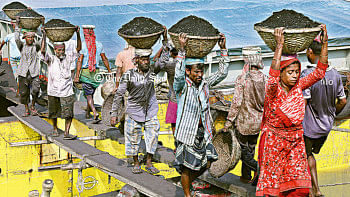Can the massive forex reserves bankroll large projects?
The government is revisiting the idea of using currently healthy foreign currency reserves boosted by the drastic fall in imports and injection of budget support from external sources to bankroll major projects.
The idea came from Prime Minister Sheikh Hasina, Planning Minister MA Mannan told reporters yesterday.
The argument is the reserves have shot past $36 billion, the highest in the country's record, and Bangladesh has to borrow from external sources to finance large projects.
Now, the finance division and the central bank would explore the possibility of using the reserves to implement major projects, Mannan said.
"This is a groundbreaking proposal. We now have to formulate the guidelines," he said, adding that the government would ensure a reserve equal to three-months import bill.
Foreign currency reserves have been setting up new records for the last two months. In May, it first touched $34 billion and then $35 billion before climbing to $36 billion.
But the ballooning reserves are largely due to a slump in import payments because of the shutdown caused by the pandemic and the large disbursement in budget support from the Asian Development Bank (ADB), the International Monetary Fund (IMF), the World Bank (WB), the Asian Infrastructure Investment Bank and the Islamic Development Bank.
The country's import decreased 62 per cent year-on-year to $1.95 billion in April as industrial production has almost come to a halt due to the ongoing shutdown.
So, the idea has evoked caution.
The proposal to use foreign exchange reserves for investment in infrastructure must be examined with extreme care and caution, said Zahid Hussain, a former lead economist of the WB's Dhaka office.
"Reserve is a tool that is most useful in distressed circumstances such as the one the economy is currently going through."
The current account deficit has been widening since February primarily because of a sharp fall in exports and deceleration in remittance growth. These pressures are unlikely to subside in the near future.
The budget support from the multilateral organisations is not sustainable sources of reserve increase. However, the current account deficit is most likely to continue to increase.
It will, therefore, be important to make sure that the level of reserves is adequate to meet at least seven to eight months of imports of goods and services and not three months, Hussain said.
The three-month threshold is the minimum level of reserve adequacy in normal times.
"But these are not normal times. If there is any excess reserve over that required to meet seven to eight months of imports, that excess can be used, as a last resort, for high priority infrastructure projects that are in an advanced stage of completion," he added.
In June 2017, the IMF said given Bangladesh's slow export growth and decline in remittance inflows, the safe reserve limit should be equal to 9.6 months' import bill.
But the export scenarios are now horrendous: exports, the country's main foreign currency earner, plummeted 16.93 per cent to $33.67 billion in the just-concluded fiscal year and nobody can say with certainty when it would pick up given the messy situation around the coronavirus pandemic.
Remittance hit an all-time high of $18.20 billion in the last fiscal year, giving much-needed breathing space to the government to manage the macroeconomic state of affairs hit hard by the ongoing financial whiplash.
But the causes of the increase can't be explained properly as more and more migrant workers are returning home as the host countries themselves are struggling to contain the deadly virus and the outflow of migrant workers from Bangladesh has fallen.
The government had been thinking about using foreign currency reserves for a long time.
In 2015, the government had formed a seven-member team to evaluate the prospects of using reserves funds. The team submitted its report in December 2016.
Two years ago, the cabinet gave the go-ahead for the setting up of a fund with money from the foreign currency reserves, which would be used for government investment in long-term projects.
The funds to the tune of $10 billion were supposed to be used for investments in seven sectors, including power, energy and in large infrastructure projects.
The IMF approved $732 million, the ADB $500 million and the WB $250 million in budget support for Bangladesh, among other lenders.



 For all latest news, follow The Daily Star's Google News channel.
For all latest news, follow The Daily Star's Google News channel. 



Comments